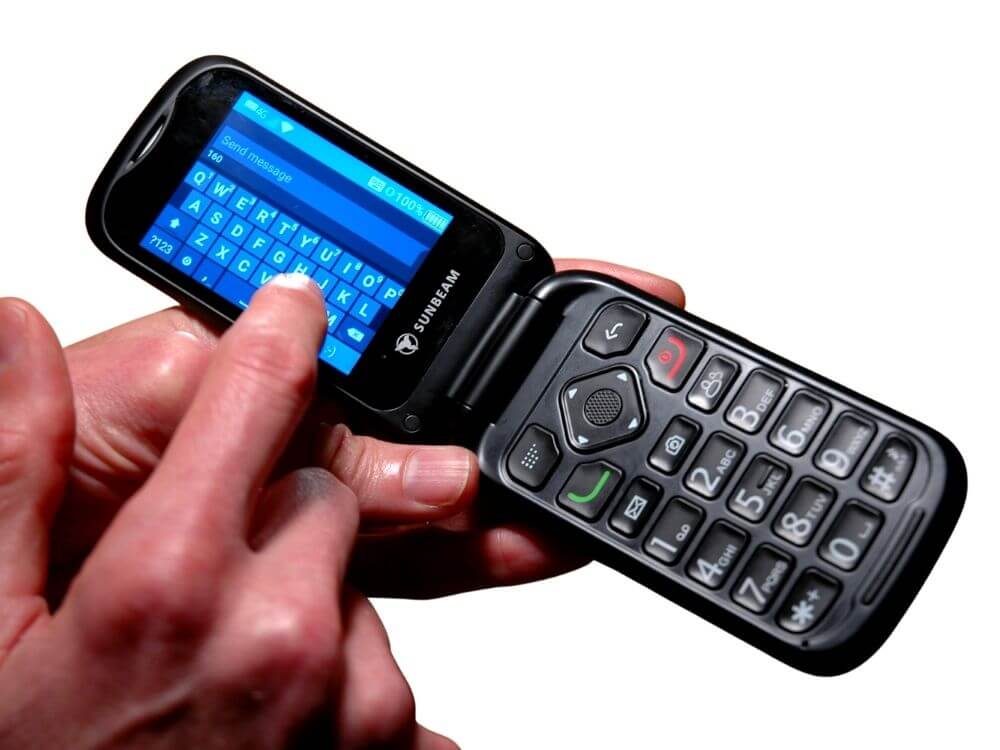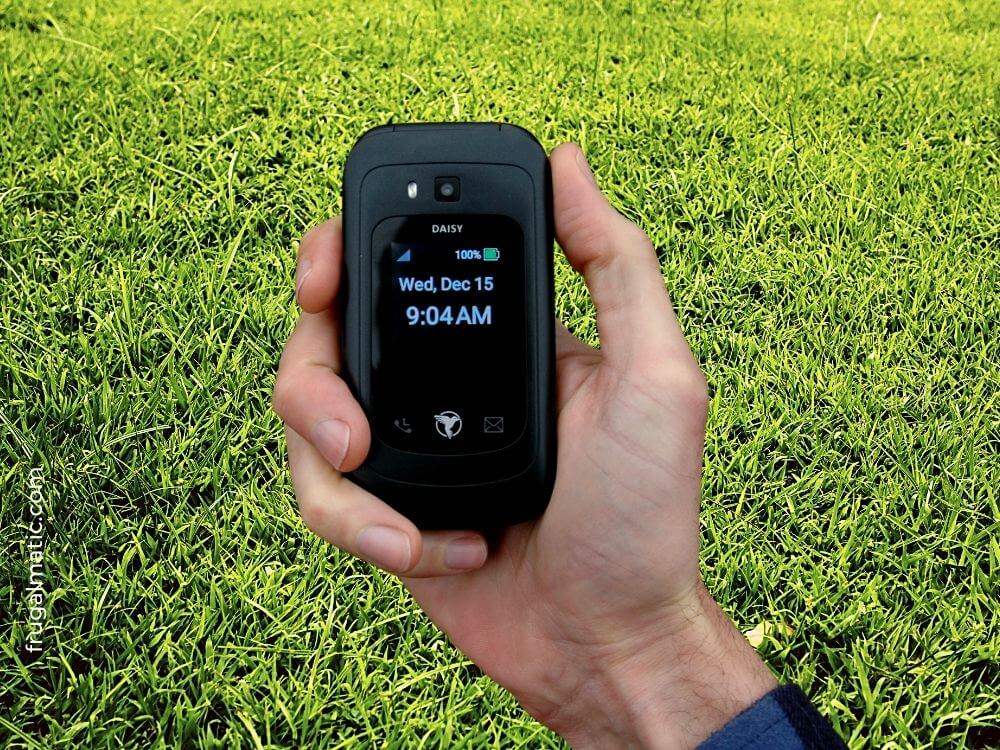This post was last updated on July 8th, 2024 at 08:55 am
In our smartphone-dominated world, it can be difficult to find a high-quality “dumb” phone. I know because, for nearly two years, I used a device that would often crash or “freeze up.” While feeling disappointed, I thought these problems were the price I had to pay for living without a smartphone. Thankfully, I’ve recently been proven wrong. I switched to a phone that’s great for practicing digital minimalism: the Sunbeam F1.
Years ago, I wouldn’t have dreamed of buying a high-end flip phone because the low-end phones worked perfectly fine. For seven years, I used a small, nondescript LG flip phone. I appreciated it but, honestly, took its dependability and amazing battery life (nearly two weeks!) for granted. As I wrote in an October 2020 post, I only stopped using it in 2019 because my carrier at the time was closing its 3G network.
Navigating the new flip-phone world
As I looked for a new “dumb” phone, I just assumed every flip phone would be like my little LG. What a mistake! I bought an Alcatel phone and immediately regretted it. The Alcatel must have sensed my displeasure because it seemed to crash only when I had an important call to make. And if it wasn’t crashing, the operating system would take too long to transition between functions.
Then about three months ago, I decided enough was enough. That’s when I learned about Sunbeam Wireless and its line of $195 F1 flip phones: the Dandelion, Daisy, and Orchid.
I reached out to the Missouri-based company, founded by Sterling Martin and Nelson Hoover in 2018, to inquire about their product. Full disclosure: They gave me a device after learning about my website and commitment to digital minimalism. In a note, Martin asked me to “please provide an honest review, whether positive or negative, as they are the best kind.”
Admittedly, my Alcatel experience had set the bar pretty low. It wouldn’t have taken much to impress me. But previous disappointments aside, I must say the Sunbeam phone exceeded my expectations. Indeed, in terms of functionality, it is a notch above that dependable LG device I had used for seven years. Time will tell whether it’s as durable.
Sunbeam phone makes functionality the top priority
Far and away, I’m most impressed with Sunbeam’s customized operating system. Like the flip phones of yesteryear, the Sunbeam OS runs smoothly and cleanly, quickly transitioning between tools. This OS respects your time. With its intuitive interface, it’s easy to find and launch the different tools.
Plus, you don’t have to worry about any unnecessary apps hiding somewhere and spying on you. Sunbeam doesn’t support internet browsers or apps, except the navigation and weather software that comes with the Orchid version.
I have the Daisy version, which includes calls and texts. (The Dandelion only allows calls.) The tools enhance the phone’s functionality without making the phone feel like it’s pretending to be smartphone. In particular, I appreciate the voice-to-text tool. Powered by Microsoft, voice-to-text is both fast and accurate. But if you prefer to type out text messages, the phone has a touchscreen keypad that I find easier to use than the phone’s physical buttons.
It’s important to note: Accessing voice-to-text requires data through your phone carrier, though this features consumes very little data. It also requires a Sunbeam Premium Services subscription of $3.50 per month (with a 30-day free trial). You’ll also need the premium subscription to also use the Orchid’s navigation and weather tools.

Sunbeam phone also great for privacy
In buying this premium service, you’re not only paying for the service itself but a high level of privacy, as Sunbeam outlines on its FAQ page. I asked Martin about the company’s privacy commitment, and here was his response:
“Our purpose is to help people live intentional lives with real relationships. So our primary goal is not privacy. However, many of our customers are not comfortable with social media and Big Data tracking their every move, many times for a profit,” Martin stated in an email. “And neither are we. So even though our primary goal is not privacy, we value the privacy of the customer and always choose the least-invasive option.”
I don’t use weather or navigation (Read: How to navigate without GPS), so I’m not too worried about Big Data tracking me. But my thought is, if you’re going to be a digital minimalist, you might as well invest in a phone designed to protect your privacy. Sunbeam leaves no question in my mind that they’re doing their best to shield users’ phone activity.
When I consider what role I want technology to play in my life, I want to be in control. I want to know how and when my information is being used. That’s possible with the Sunbeam F1 because the company shares my values on mobile technology.
Read: This phone is so dumb, it’s brilliant: The Zero G
A device for the practical minded
There are, of course, other companies out there that share these values. What separates Sunbeam, in my mind, is not the privacy element so much as the company’s focus on functionality. Sunbeam didn’t spend years trying to design a “hip” device, or fashion accessory, like some other digital minimalist players. Rather, Sunbeam spent its resources on developing the operating system and the phone’s tools. My disappointment with many “dumb” phones is not so much with their hardware but their software, which many companies have treated like an afterthought.
Sunbeam phones are designed with an understanding of what type of customer they are serving. The hardware and software complement each other, and it’s worth noting that PC Magazine included the phone in its Best Products of 2021 list. The inclusion followed an upbeat review by Sascha Segan.
At Frugalmatic, practicality matters most, and the Sunbeam is a practical device above all else.
Downside of the Sunbeam phone
If I had a complaint, it would be the battery life. My Daisy version lasts about one day or so, depending on usage amounts, a far cry from the days when my LG ran for more than a week on a single charge. According to Sunbeam, the days of long battery life are over because of large energy requirements for processing VoLTE signals.
If you’re interested in trying the Sunbeam but aren’t sure whether it’s compatible on your network, Sunbeam provides a list of compatible providers. It works well on most major carriers and many small ones.
Support is important, too
With a Sunbeam phone, you receive support. If you have concerns or questions, you can count on the company to be responsive. It’s easy to take support services for granted until you have problem or question and need help.
And let’s face it, when you don’t have a smartphone and everyone else around you does, it can feel a little isolating. For that reason alone, it’s important to get a device that comes with quality support. I feel that Sunbeam recognizes the significance of forgoing a smartphone and wants you to be successful in your decision.
UPDATE: Almost two years of using my Sunbeam phone
As of August 2023, I’m still using the Sunbeam phone. I’ve dropped it a handful of times, and it’s survived the falls. It’s not considered a rugged phone, but it’s not flimsy.
The only issue I’ve had is the occasional software bug. Sunbeam does provide regular updates, which have fixed these bugs. If you notice any, the phone includes a feature to report them, and you can also email or call the company. I’ve personally reported two bugs over the past two years. In each case, a Sunbeam representative responded to me and offered help. Most recently, the company told me that the bug I had reported was a “known bug” and “will be repaired as soon as we create an update.” The patch became available about a week later.
None of the bugs have prevented me from using the phone, as I’ve always been able to find a workaround. The truth is, every program comes with bugs, from time to time. What’s important is how a company handles them. In my experience, Sunbeam issues timely software updates and promptly responds to support requests.
With the Sunbeam phone, you will receive notifications when updates become available. You can also manually check for them through the “Update Software” and “Update Firmware” menu options.
UPDATE[2]: My switch to the Sunbeam F1 Pro
As of May 2024, I began using the Sunbeam F1 Pro. It uses the same operating system as the original F1. The main difference is F1 Pro is physically more substantial than the original F1. The F1 Pro is a little larger and weighs about two ounces more than the original F1. Perhaps the biggest benefit is the longer battery life.
Make sure to check out my complete review of the F1 Pro for more details.
Read: 5 tips for dealing with ‘digital gates’
Q & A with Sunbeam co-founder Sterling Martin
Read excerpts from my Q & A with Sunbeam Wireless co-founder Sterling Martin below.
Frugalmatic: I understand some of the interest in your phone is for religious reasons and some of it for secular reasons. It sounds like you have a wide-ranging group of customers. Can you talk a little bit about what types of people are buying your phone?
Sterling Martin: Yes, you are correct about that. We do indeed serve a range of customers. The customers who use our phone for religious reasons tend to be Jewish, Mennonite, or Amish, although there are some exceptions. In some of the most conservative of these groups, it’s not really considered to be acceptable to use a smartphone. (There are exceptions for various reasons, including workplace.) These customers are looking for a phone that does not have a web browser or social media apps, but they still want the phone to be relatively fast to navigate: menus, access contacts, etc.
Another type of customer are those who simply prefer the flip-phone format (versus smartphone) and the tactile response of the buttons. These users tend to be older but can be younger as well. These customers might be religious or secular.
Finally, some customers are concerned about their digital footprint, as well as wanting to place some intentional limits on the amount of social media in their lives. For these users, the Sunbeam F1 is a good choice because it prevents them from having 24/7 access to the endless scroll (aka doom-scrolling) that is prevalent on many social media platforms.
Read: Should you give your child a smartphone?
F: Why did you decide on the classic flip-phone style for the Sunbeam F1?
SM: Good question. Quite frankly, we wanted to make a device with a QWERTY keypad when we started out. But after discovering that virtually all the manufacturers have moved away from these formats, and that starting a project “ground-up” would be very expensive, we decided to start with a flip phone. We know that even if we develop a QWERTY device later on, there will still be customers who want a flip phone. And since the flip phone is less expensive for our first product, it was a natural fit.
Frugalmatic: I find the debates over which features to include on minimalist devices fascinating. You’ve created three different types of phones—the Dandelion, Daisy, and Orchid—to give your customers a choice over which type of features to access. What inspired you to offer these three versions, instead of just one version offering all features?
SM: Well, our concept is to simplify the process as much as possible for the customer and have a product that fits their needs right out of the box. We have some customers that are buying the phone for a parent with dementia, and they do not want anything popping up or confusing them, such as incoming spam text messages. For these folks, the Dandelion is a good fit.
But quite frankly, texting is a major part of most customers’ daily phone experience, so we needed a version with texting. For someone wanting the functionality of a traditional flip phone of days gone by, the Daisy is a good fit. It offers calling, texting, and a number of tools like calculator, calendar, etc., but that’s about it. For someone who only wants the functions, and nothing more, the Daisy is great. Finally, we’ve added Maps and Weather to our Orchid version. Navigation is almost essential for some people, which is why we’ve made the Orchid version.
F: Your company prioritizes privacy and doesn’t include software on the device that tracks user activity. Why is that so important to you and your customers?
SM: Our purpose is to help people live intentional lives with real relationships. So our primary goal is not privacy. However, many of our customers are not comfortable with social media and Big Data tracking their every move, many times for a profit. And neither are we. So even though our primary goal is not privacy, we value the privacy of the customer and always choose the least-invasive option.
For example, in our experience we’ve found that if we wish to provide a good voice-to-text feature on our phones, we will need to work with a large company that has a powerful voice transcription engine. We’ve partnered with Microsoft for our voice-to-text service, which is extremely accurate and powerful. Not all of our customers like Microsoft, but we believe that our implementation of it is a good balance between a solution that works well and keeping the customer’s data private.

